
Consider the reaction sequence from P to Q shown below. The overall yield of the major product Q from P is 75%. What is the amount in grams of Q obtained from 9.3 mL of P? (Use density of P \[ = 1.00{\text{ }}g{\text{ }}m{L^{ - 1}}\] ; Molar mass of\[C = 12.0\] , \[H = 1.0\] , \[O = 16.0\] and \[N = 14.0{\text{ }}g{\text{ }}mo{l^{ - 1}}\] )
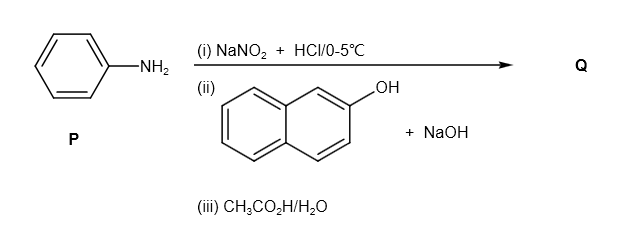
Answer
218.7k+ views
Hint: The given compound P is aniline. It is reacted with \[NaN{O_2} + HCl\] . Diazonium salt functions as an electrophile. Therefore, it produces diazonium salt. This salt further reacted with beta naphthol and sodium hydroxide. And after that, it will react with acetic acid and water. By using the reaction stoichiometry and molar mass calculations, we have to calculate the amount of Q obtained.
Complete Step by Step Solution:
The given compound P is as follows:
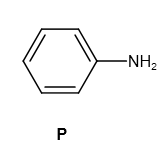
It reacts with \[NaN{O_2} + HCl\] and produces diazonium salt as follows:

Further, it reacts with \[\beta - \] naphthol and sodium hydroxide as follows:
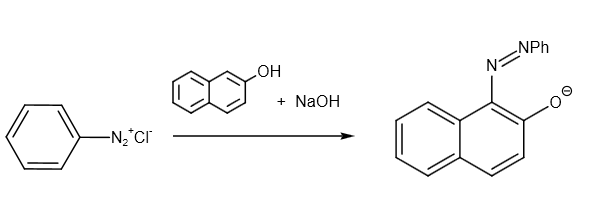
Further, it reacts with \[C{H_3}C{O_2}H/{H_2}O\] as follows:
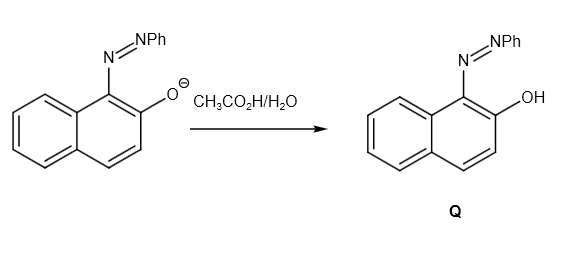
Therefore, the overall reaction can be written as follows:
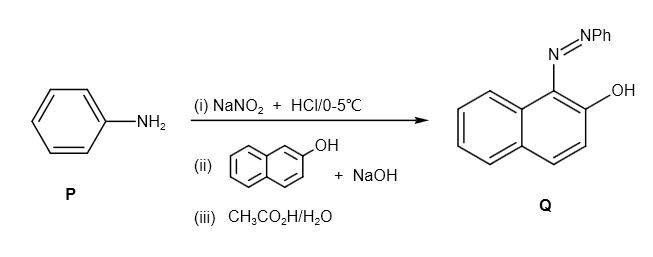
One mole of P produces one mole of Q.
Molar mass of \[{C_6}{H_7}N = 93\,g\,mo{l^{ - 1}}\]
Molar mass of \[{C_{16}}{H_{12}}{N_2}O = 248\,g\,mo{l^{ - 1}}\]
So, we can say that \[93\,g\] of P produces \[248\,g\] of Q.
The given volume of P is \[9.3\,mL\] .
Density of P \[ = 1.00{\text{ }}g{\text{ }}m{L^{ - 1}}\]
We know that,
\[ m = d \times V \\
\Rightarrow m = 1.0\,g\,m{L^{ - 1}} \times 9.3\,mL \\
\Rightarrow m = 9.3\,g \\ \]
Calculate the number of moles of P as follows:
\[ {\text{No}}{\text{.}}\,{\text{of moles}} = \dfrac{{9.3\,g}}{{93\,g\,mo{l^{ - 1}}}} \\
\Rightarrow {\text{No}}{\text{.}}\,{\text{of moles}} = 0.1\,mol \\ \]
One mole of P produces one mole of Q.
\[0.1\,mol\] of P produces \[0.1\,mol\] of Q.
Now,
\[ {\text{No}}{\text{. of moles}} = \dfrac{{{\text{mass}}}}{{{\text{molar}}\,{\text{mass}}}} \\
\Rightarrow {\text{mass}} = {\text{No}}{\text{. of moles}} \times {\text{molar}}\,{\text{mass}} \\ \]
Calculate the mass of Q as follows:
\[ {\text{mass}} = {\text{No}}{\text{. of moles}} \times {\text{molar}}\,{\text{mass}} \\
\Rightarrow {\text{mass}} = 0.1 \times 248 \\
\Rightarrow {\text{mass}} = 24.8 \\ \]
The yield of the reaction is \[75\% \] .
Calculate the actual amount of Q as follows:
\[ {\text{mass}} = 24.8 \times \dfrac{{75}}{{100}} \\
\Rightarrow {\text{mass}} = 18.6\,g \\ \]
Therefore, the mass of Q is \[18.6\,g\] .
Note: Molar mass is the amount of mass that makes up one mole of a substance. It may also be referred to as the mass of the substance, measured in grammes, that makes up one mole of the substance. There are \[6.023 \times {10^{23}}\] molecules in a mole. It is known as Avogadro's number. The most significant concept in physical chemistry is molar mass. The molar mass, the molar mass formula, the molecular mass and its formula, the distinction between the molar and molecular masses, and the relative molar mass and its formula are all topics covered in this article.
Complete Step by Step Solution:
The given compound P is as follows:

It reacts with \[NaN{O_2} + HCl\] and produces diazonium salt as follows:

Further, it reacts with \[\beta - \] naphthol and sodium hydroxide as follows:

Further, it reacts with \[C{H_3}C{O_2}H/{H_2}O\] as follows:

Therefore, the overall reaction can be written as follows:

One mole of P produces one mole of Q.
Molar mass of \[{C_6}{H_7}N = 93\,g\,mo{l^{ - 1}}\]
Molar mass of \[{C_{16}}{H_{12}}{N_2}O = 248\,g\,mo{l^{ - 1}}\]
So, we can say that \[93\,g\] of P produces \[248\,g\] of Q.
The given volume of P is \[9.3\,mL\] .
Density of P \[ = 1.00{\text{ }}g{\text{ }}m{L^{ - 1}}\]
We know that,
\[ m = d \times V \\
\Rightarrow m = 1.0\,g\,m{L^{ - 1}} \times 9.3\,mL \\
\Rightarrow m = 9.3\,g \\ \]
Calculate the number of moles of P as follows:
\[ {\text{No}}{\text{.}}\,{\text{of moles}} = \dfrac{{9.3\,g}}{{93\,g\,mo{l^{ - 1}}}} \\
\Rightarrow {\text{No}}{\text{.}}\,{\text{of moles}} = 0.1\,mol \\ \]
One mole of P produces one mole of Q.
\[0.1\,mol\] of P produces \[0.1\,mol\] of Q.
Now,
\[ {\text{No}}{\text{. of moles}} = \dfrac{{{\text{mass}}}}{{{\text{molar}}\,{\text{mass}}}} \\
\Rightarrow {\text{mass}} = {\text{No}}{\text{. of moles}} \times {\text{molar}}\,{\text{mass}} \\ \]
Calculate the mass of Q as follows:
\[ {\text{mass}} = {\text{No}}{\text{. of moles}} \times {\text{molar}}\,{\text{mass}} \\
\Rightarrow {\text{mass}} = 0.1 \times 248 \\
\Rightarrow {\text{mass}} = 24.8 \\ \]
The yield of the reaction is \[75\% \] .
Calculate the actual amount of Q as follows:
\[ {\text{mass}} = 24.8 \times \dfrac{{75}}{{100}} \\
\Rightarrow {\text{mass}} = 18.6\,g \\ \]
Therefore, the mass of Q is \[18.6\,g\] .
Note: Molar mass is the amount of mass that makes up one mole of a substance. It may also be referred to as the mass of the substance, measured in grammes, that makes up one mole of the substance. There are \[6.023 \times {10^{23}}\] molecules in a mole. It is known as Avogadro's number. The most significant concept in physical chemistry is molar mass. The molar mass, the molar mass formula, the molecular mass and its formula, the distinction between the molar and molecular masses, and the relative molar mass and its formula are all topics covered in this article.
Recently Updated Pages
The hybridization and shape of NH2 ion are a sp2 and class 11 chemistry JEE_Main

What is the pH of 001 M solution of HCl a 1 b 10 c class 11 chemistry JEE_Main

Aromatization of nhexane gives A Benzene B Toluene class 11 chemistry JEE_Main

Show how you will synthesise i 1Phenylethanol from class 11 chemistry JEE_Main

The enolic form of acetone contains a 10sigma bonds class 11 chemistry JEE_Main

Which of the following Compounds does not exhibit tautomerism class 11 chemistry JEE_Main

Trending doubts
JEE Main 2026: Application Form Open, Exam Dates, Syllabus, Eligibility & Question Papers

Derivation of Equation of Trajectory Explained for Students

Hybridisation in Chemistry – Concept, Types & Applications

Understanding the Angle of Deviation in a Prism

Understanding Collisions: Types and Examples for Students

Understanding Atomic Structure for Beginners

Other Pages
NCERT Solutions For Class 11 Chemistry Chapter 7 Redox Reaction

JEE Advanced Marks vs Ranks 2025: Understanding Category-wise Qualifying Marks and Previous Year Cut-offs

Thermodynamics Class 11 Chemistry Chapter 5 CBSE Notes - 2025-26

NCERT Solutions ForClass 11 Chemistry Chapter Chapter 5 Thermodynamics

Equilibrium Class 11 Chemistry Chapter 6 CBSE Notes - 2025-26

How to Convert a Galvanometer into an Ammeter or Voltmeter




